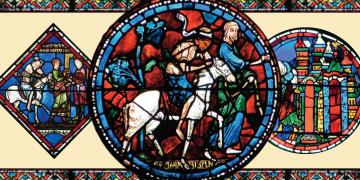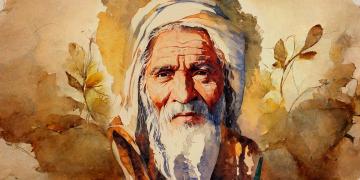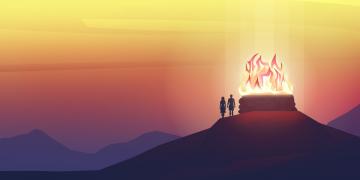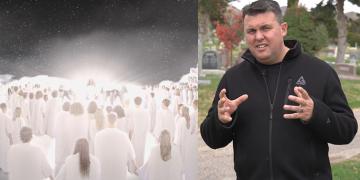You are here
Book of Mormon Central is in the process of migrating to our new Scripture Central website.
We ask for your patience during this transition. Over the coming weeks, all pages of bookofmormoncentral.org will be redirected to their corresponding page on scripturecentral.org, resulting in minimal disruption.
The Atonement of Jesus Christ is the most central doctrine of The Church of Jesus Christ of Latter-day Saints. Latter-day Saints believe that all mankind can be saved through the Atonement of Jesus Christ, and that He can empathize with all the sufferings, infirmities, and pain inherent to mortality. Throughout the history of Christ’s restored Church, its leaders and members have put sacred emphasis on Gethsemane as the place where Christ suffered for mankind’s sins and afflictions.1 Thus, for many Latter-day Saints, Gethsemane has become a central focus of Christ’s Atonement.2
However, both ancient and modern prophets have encouraged us to also look to the Crucifixion of Jesus Christ as the source of salvation.3
The sacrificial death of Jesus Christ is integral to Christ’s Atonement. Latter-day Saints can get closer to God and develop a greater appreciation for the Atonement as they study and ponder the importance of the Crucifixion in their lives. The Book of Mormon, the Doctrine and Covenants, and teachings from modern prophets give Latter-day Saints important reasons to pay closer attention to this vital topic.
1. The Book of Mormon actually has more to say about the death of Christ than His sufferings in Gethsemane
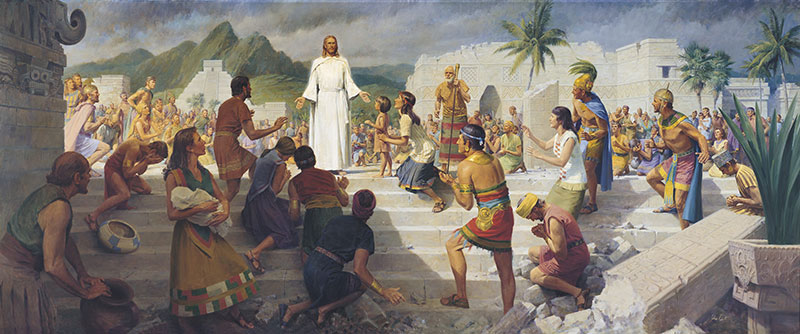
Jesus Christ Visits the Americas by John Scott. Image via Gospel Media Library.
The Book of Mormon can give Latter-day Saints a profound appreciation for the sacrificial death of Christ. In several ways, the book enriches our understanding of the Savior’s sufferings in Gethsemane (Mosiah 3:7; Alma 7:11), but it also consistently emphasizes Christ’s death as a key part of His Atonement. While only a handful of Book of Mormon passages potentially allude to Christ’s sufferings in Gethsemane, over 40 of them teach about the importance of His crucifixion.4
For example, the idea that Christ was “lifted up” on the cross is a recurring theme in the Book of Mormon. Jesus Christ best taught this concept when He visited the Nephites in America:
And my Father sent me that I might be lifted up upon the cross; and after that I had been lifted up upon the cross, that I might draw all men unto me, that as I have been lifted up by men even so should men be lifted up by the Father, to stand before me, to be judged of their works, whether they be good or whether they be evil—
And for this cause have I been lifted up; therefore, according to the power of the Father I will draw all men unto me, that they may be judged according to their works.5
In these scriptures, when Jesus Christ defines His gospel and Atonement, He does so in terms of the cross.6 The beautiful purpose of Christ’s Crucifixion, as defined by Himself, is to exalt all of mankind if they will accept His Atonement (Moses 1:39).
2. The signs of Christ’s Crucifixion were so important that Jesus kept them in the resurrection
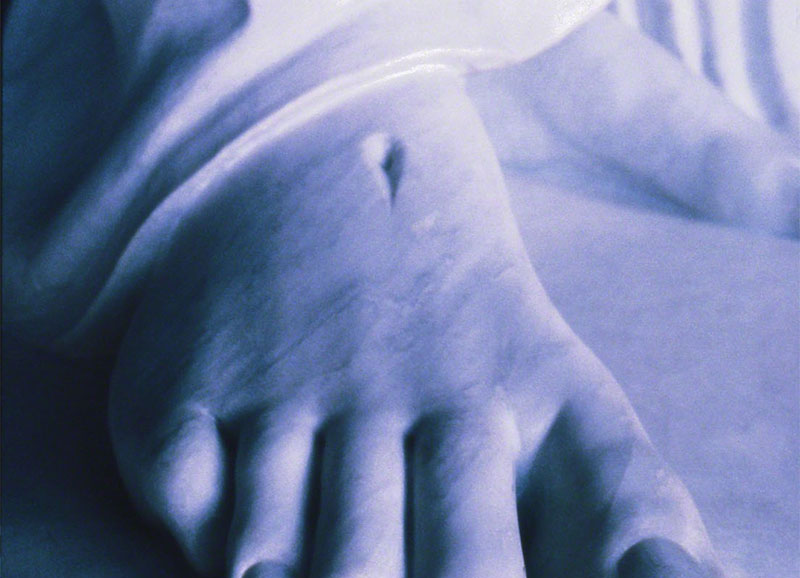
Foot of the Christus statue. Image via Gospel Media Library.
After enduring the infinite pain and suffering of the Atonement, Jesus rose again from the dead in a resurrected, glorified, perfected body. Yet His “perfect” body still contained the marks of crucifixion, namely the nail prints in His hands and feet, and the incision in His side.
At least one of the reasons Christ kept these signs was to help identify Him as the Son of God and the Savior of the World.7 For the disciples in the New Testament, the nail prints in Christ’s hands and feet indicated that He was the same man who had died on the cross, but was now alive (John 20:27; Luke 24:39).
The Nephites in the Americas had never seen Jesus Christ, yet the mark on His side may have helped identify Him as someone who had been ritually sacrificed. Mesoamerican scholar Mark Wright explained, “To a people steeped in Mesoamerican culture, the sign that a person had been ritually sacrificed would have been an incision on their side — suggesting they had had their hearts removed.”8
The disciples in the Old World knew that Jesus had died; the marks in His body were the witness that He had risen from the dead. The disciples in the New World clearly saw Jesus alive; the marks on His body witnessed to them that Christ had sacrificially died.9
It’s also possible that Jesus kept the wound marks on His body to serve as a reminder of the great personal suffering and cost of His Atonement. Elder Jeffrey R. Holland has expounded,
As a reminder of those days, Jesus has chosen, even in a resurrected, otherwise perfected body, to retain for the benefit of His disciples the wounds in His hands and in His feet and in His side—signs, if you will, that painful things happen even to the pure and the perfect; signs, if you will, that pain in this world is not evidence that God doesn’t love you; signs, if you will, that problems pass and happiness can be ours. . . . It is the wounded Christ who is the Captain of our souls, He who yet bears the scars of our forgiveness, the lesions of His love and humility, the torn flesh of obedience and sacrifice. These wounds are the principal way we are to recognize Him when He comes.10
3. Nephi’s Tree of Life may symbolize the crucifixion of Jesus Christ
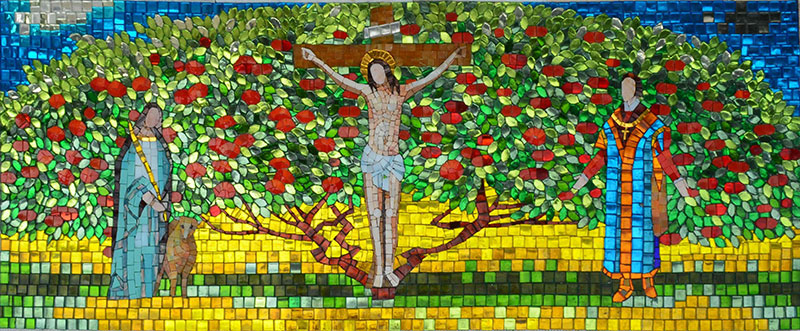
Image via Mozaico.
One of the powerful messages of the Book of Mormon is that Jesus Christ performed the Atonement out of love for us. In Nephi’s vision of the Tree of Life, an angel helped him learn that the Tree of Life is a symbol of “the love of God, which sheddeth itself abroad in the hearts of the children of men” (1 Nephi 11:22).
Nephi then learned what the love of God really entails, as he witnessed the life, ministry, and culminating death of Jesus Christ. “And I, Nephi, saw that he was lifted up upon the cross and slain for the sins of the world” (1 Nephi 11:33). In some ways, the Tree of Life may symbolize the tree upon which Jesus Christ was hanged when he was crucified for the sins of the world (Deuteronomy 21:23).11
4. The Crucifixion is integral to the Atonement
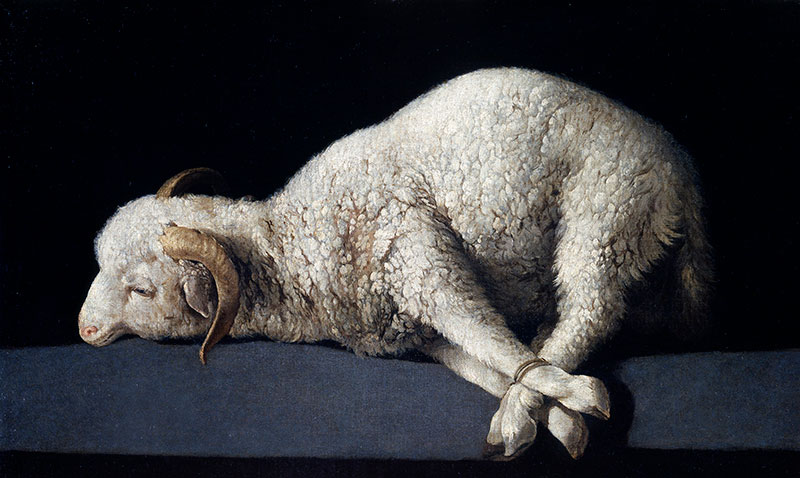
Agnus Dei by Francisco de Zurbarán via Wikimedia Commons.
Certainly, the most important reason Latter-day Saints should study, ponder, and appreciate the Crucifixion of Jesus Christ is because it was part of the Atonement. The Fall of Adam caused mortality, sin, and suffering to enter the world. Man could never return to the presence of God without an infinite and eternal sacrifice (Alma 34:12).12 To anticipate this sacrifice, disciples offered animal sacrifices since the time of Adam (Moses 5:6–8). These sacrifices served as a similitude of Jesus Christ—the Lamb of God—whose infinite and eternal sacrifice was completed when He died for our sins on the cross.13
The Book of Mormon makes it abundantly clear that the death of Jesus Christ is tied to His atoning power. To those gathered at the temple in Bountiful, Jesus explained that He was “slain for the sins of the world” (3 Nephi 11:4, emphasis added). Moroni likewise affirmed that “all men are redeemed, because the death of Christ” (Mormon 9:13, emphasis added). And during his mission to the Lamanites, Aaron testified that “there could be no redemption for mankind save it were through the death and sufferings of Christ, and the atonement of his blood” (Alma 21:9, emphasis added).
Elder Bruce R. McConkie testified,
And now, as pertaining to this perfect atonement, wrought by the shedding of the blood of God—I testify that it took place in Gethsemane and at Golgotha, and as pertaining to Jesus Christ, I testify that he is the Son of the Living God and was crucified for the sins of the world. He is our Lord, our God, and our King. This I know of myself independent of any other person.14
Latter-day Saints will gain understanding, inspiration, and spiritual power as they better recognize how the Crucifixion of Jesus Christ is an important part of His Atonement. Christ’s Crucifixion—along with His perfect life of service, His infinite suffering in Gethsemane, and His glorious Resurrection—opens the gates of redemption for all mankind and prepares a way for each of us to return to the presence of Heavenly Father.
- 1. James E. Talmage was among the first to put special emphasis on Gethsemane as the place where Jesus Christ suffered for the sins and infirmities of mankind. See James E. Talmage, Jesus the Christ: A Study of the Messiah and His Mission According to Holy Scriptures Both Ancient and Modern (Salt Lake City, UT: Deseret Book, 1915, 1983), 613. For select treatments of the Atonement, Gethsemane, and the Crucifixion before Talmage, see Letter to the Church, circa March 1834, p. 143. The Joseph Smith Papers, accessed June 2, 2019; Revelation Book 1, Vision, 16 February 1832 (D&C 76:68–70), p. 136–137. The Joseph Smith Papers, accessed June 2, 2019; Letter from Oliver Cowdery, 6 November 1829, p. 7. The Joseph Smith Papers, accessed June 2, 2019; Journal of Discourses 8:115 (1861); Journal of Discourses 12:33 (1869); Journal of Discourses 13:59 (1871); Anthony H. Lund, Conference Report, April 1912, 11–12; Joseph E. Robinson, Conference Report, April 1918, 45–46 . Latter-day Saint emphasis on Gethsemane likely stems from a specific reading of Luke 22:44 which describes Jesus’ sweat as bloody drops. Despite textual critical issues with the passage, Latter-day Saints draw special meaning from this passage based on teachings from Mosiah 3:7 and D&C 19:18 that also describe a bloody sweat. From these scriptures and additional commentary from modern apostles and prophets come the distinctive Latter-day Saint belief that Jesus Christ suffered for the sins and infirmities of mankind in Gethsemane, not exclusively during the crucifixion.
- 2. See Marion G. Romney, Conference Report, October 1953, 35; Joseph Fielding Smith, Doctrines of Salvation, Volume 1, ed. Bruce R. McConkie (Salt Lake City, UT: Bookcraft, 1954–1956), 1:130; Spencer W. Kimball, Conference Report April 1961, 81; Marion G. Romney, Conference Report, April 1961, 119–120; Marion G. Romney, “The Resurrection of Jesus,” Ensign, May 1982, paragraph 7, 12; Ezra Taft Benson, “Valiant in the Testimony of Jesus,” Ensign, May 1982, paragraph 7; Bruce R. McConkie, “The Seven Christs,” Ensign, November 1982, paragraph 36–38; Neal A. Maxwell, “Willing to Submit,” Ensign, May 1985, paragraph 43–49; Bruce R. McConkie, “The Purifying Power of Gethsemane,” Ensign, May 1985.
- 3. For a new analysis of Latter-day Saint perception of Gethsemane and the Crucifixion, see John Hilton III, "Teaching the Scriptural Emphasis on the Crucifixion of Jesus Christ," Religious Educator 20, no. 3 (2019): 133–53.
- 4. 1 Nephi 10:11; 1 Nephi 11:33; 1 Nephi 19:10; 1 Nephi 19:13; 2 Nephi 2:8; 2 Nephi 6:9; 2 Nephi 9:5; 2 Nephi 10:3–5; 2 Nephi 25:13–14; 2 Nephi 26:3; Jacob 1:8; Mosiah 3:7–9; Mosiah 14:12; Mosiah 15:7; Mosiah 16:7–8; Mosiah 18:2; Alma 7:12; Alma 11:42; Alma 16:19; Alma 21:9; Alma 22:4; Alma 24:13; Alma 34:10–12; Helaman 8:14–15; Helaman 14:14–16; Helaman 14:20; 3 Nephi 6:20; 3 Nephi 9:22; 3 Nephi 11:2; 3 Nephi 11:14; 3 Nephi 18:11; 3 Nephi 27:14–15; 3 Nephi 28:6; Ether 4:1; Mormon 9:13; Moroni 5:2; Moroni 9:25; Moroni 10:33.
- 5. 3 Nephi 27:14–15; cf. 1 Nephi 11:33; 1 Nephi 19:10; Helaman 8:14–15; 3 Nephi 28:6.
- 6. Gaye Strathern, “Christ’s Crucifixion: Reclamation of the Cross” in With Healing in His Wings, ed. Camille Fronk Olson and Thomas A. Wayment (Salt Lake City and Provo, UT: Deseret Book and Religious Studies Center, Brigham Young University, 2013), 55–79.
- 7. Strathern, “Christ’s Crucifixion: Reclamation of the Cross,” 55–79.
- 8. Mark Alan Wright, “Axes Mundi: Ritual Complexes in Mesoamerica and the Book of Mormon,” Interpreter: A Journal of Mormon 12 (2014): 91.
- 9. See Book of Mormon Central, “Why Did the Savior Emphasize His Risen Body in the Nephite Sacrament? (3 Nephi 18:7),” KnoWhy 211 (October 18, 2016).
- 10. Jeffrey R. Holland, “Teaching, Preaching, Healing,” Ensign, January 2003, 42.
- 11. For a Mesoamerican perspective on the Tree of Life being a symbol for a god's death, see Allen J. Christenson, "Maya Harvest Festivals and the Book of Mormon," Review of Books on the Book of Mormon, 3, no. 1 (1991): 28–29.
- 12. See Book of Mormon Central, “Why Must There be an Infinite and Eternal Sacrifice? (Alma 34:12),” KnoWhy 142 (July 13, 2016).
- 13. In Gethsemane, Jesus Christ prayed to the Father to have the bitter cup removed (Luke 22:42–44). However, when Jesus Christ willingly took upon Himself the sins of all the world, He was ready to serve as infinite and eternal sacrificial lamb, and die for the sins of the world. For discussions where church leaders suggest that Gethsemane was a time when Jesus anticipated the suffering of the crucifixion, see Lorenzo Snow, Conference Report, October 1893; Anthon H. Lund, Conference Report, April 1912, 11–12; Anthon H. Lund, Conference Report, October 1914, 12; J. Golden Kimball, Conference Report, April 1925, 121; Joseph L. Wirthlin, Conference Report, April 1948, 143.
- 14. Bruce R. McConkie, “The Purifying Power of Gethsemane,” Ensign May 1985, emphasis added.
Subscribe
Get the latest updates on Book of Mormon topics and research for free



